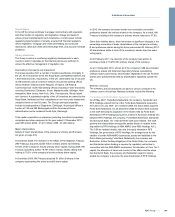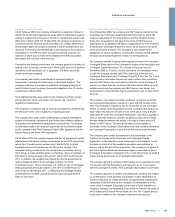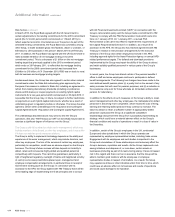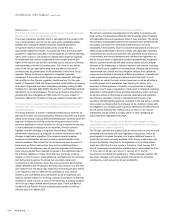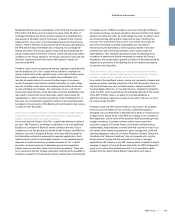RBS 2010 Annual Report Download - page 411
Download and view the complete annual report
Please find page 411 of the 2010 RBS annual report below. You can navigate through the pages in the report by either clicking on the pages listed below, or by using the keyword search tool below to find specific information within the annual report.
Lack of liquidity is a risk to the Group’s business and its ability to access
sources of liquidity has been, and will continue to be, constrained.
Liquidity risk is the risk that a bank will be unable to meet its obligations,
including funding commitments, as they fall due. This risk is inherent in
banking operations and can be heightened by a number of enterprise
specific factors, including an over-reliance on a particular source of
wholesale funding (including, for example, short-term and overnight
funding), changes in credit ratings or market-wide phenomena such as
market dislocation and major disasters. During recent years, credit
markets worldwide have experienced a severe reduction in liquidity and
term-funding. During this time, the market perception of bank credit risk
has changed significantly and banks that are deemed by the market to be
riskier have issued debt at a premium to the cost of debt for banks that
are perceived by the market as being safer. The uncertainty regarding the
perception of credit risk across different banking groups also led to
reductions in inter-bank lending, and hence, in common with many other
banking groups, the Group’s access to traditional sources of liquidity has
been, and may again be, restricted. In addition, in common with other
banking groups, the Group has experienced pressures to increase the
average maturity of its wholesale funding. An increase in the maturity of
wholesale funding has the effect of increasing the Group’s overall cost of
funding.
The Group’s liquidity management focuses on maintaining a diverse and
appropriate funding strategy for its assets, controlling the mismatch of
maturities and carefully monitoring its undrawn commitments and
contingent liabilities. However, the Group’s ability to access sources of
liquidity (for example, through the issue or sale of financial and other
instruments or through the use of term loans) during recent periods of
liquidity stress has been constrained to the point where it, in common
with many other banking groups, has had to rely on shorter term and
overnight funding with a consequent reduction in overall liquidity, and to
increase its recourse to liquidity schemes provided by central banks.
While money market conditions improved during the course of 2009 and
2010, with the Group seeing a material reduction of funding from central
banks and the issuance of non-government guaranteed term debt, further
tightening of credit markets could have a materially adverse impact on
the Group. The Group, in common with other banking groups, may need
to seek funds from alternative sources and potentially at higher costs
than has previously been the case.
In addition, there is also a risk that corporate and financial institution
counterparties with credit exposures may seek to reduce their credit
exposures to banks, given current risk aversion trends. It is possible that
credit market dislocation becomes so severe that overnight funding from
non-government sources ceases to be available.
Like many banking groups, the Group relies on customer deposits to
meet a considerable portion of its funding. Furthermore, as part of its
ongoing strategy to improve its liquidity position, the Group is actively
seeking to increase the proportion of its funding represented by customer
deposits. However, such deposits are subject to fluctuation due to certain
factors outside the Group’s control, such as a loss of confidence,
increasing competitive pressures for retail customer deposits or the
encouraged or mandated repatriation of deposits by foreign wholesale or
central bank depositors, which could result in a significant outflow of
deposits within a short period of time. There is currently heavy
competition among UK banks for retail customer deposits, which has
increased the cost of procuring new deposits and impacted the Group’s
ability to grow its deposit base. An inability to grow, or any material
decrease in, the Group’s deposits could, particularly if accompanied by
one of the other factors described above, have a materially adverse
impact on the Group’s ability to satisfy its liquidity needs unless
corresponding actions were taken to improve the liquidity profile of other
deposits or to reduce assets. Significant progress was made during the
course of 2010 in reducing non-core asset levels. While the liquidity
position of the Group may be materially adversely impacted if it is unable
to achieve the run-off and sale of non-core and other assets and
businesses as expected, the magnitude of this risk reduced during the
course of 2010. Any significant delay in those plans may nevertheless
require the Group to consider disposals of other assets not previously
identified for disposal to achieve its funded balance sheet target level.
The Group has participated in governmental support schemes including
the UK Government Credit Guarantee Scheme and the Special Liquidity
Scheme. The Credit Guarantee Scheme closed for new issuance in
February 2010 and the Special Liquidity Scheme closed for new
transactions in January 2009. All of the Group’s financing under the
United Kingdom Government Credit Guarantee Scheme and the Special
Liquidity Scheme matures in 2011 and 2012. As at 31 December 2010,
the total amount outstanding of debt instruments issued by RBS which
benefit from the United Kingdom Government Credit Guarantee scheme
was £41.5 billion. The Group expects to mitigate the impact of this
refinancing concentration through a combination of seeking funds from
alternative sources, the continuation of the Group’s balance sheet
reduction programme and other reductions in the Group’s net wholesale
funding requirement. However, there can be no assurance that such
mitigation efforts will be successful.
There can be no assurance that the measures described above,
alongside other available measures, will succeed in improving the funding
and liquidity in the markets in which the Group operates, or that these
measures, combined with any increased cost of any funding currently
available in the market, will not lead to a further increase in the Group’s
overall cost of funding or require the Group to consider disposals of other
assets not previously identified for disposal to reduce its funding
requirements, each of which could have a material adverse impact on the
Group’s financial condition and results of operations or result in a loss of
value in the Securities.
The financial performance of the Group has been materially affected by
deteriorations in borrower credit quality and it may continue to be
impacted by any further deteriorations, including as a result of prevailing
economic and market conditions, and legal and regulatory developments.
Risks arising from changes in credit quality and the recoverability of loans
and amounts due from counterparties are inherent in a wide range of the
Group’s businesses. Whilst some economies stabilised over the course
of the last two years, the Group may continue to see adverse changes in
the credit quality of its borrowers and counterparties, for example as a
result of their inability to refinance their debts, with increasing
delinquencies, defaults and insolvencies across a range of sectors (such
as the personal and financial institution sectors) and in a number of
geographies (such as the UK, the US and the rest of Europe, particularly
Ireland).
409RBS Group 2010
Additional information


